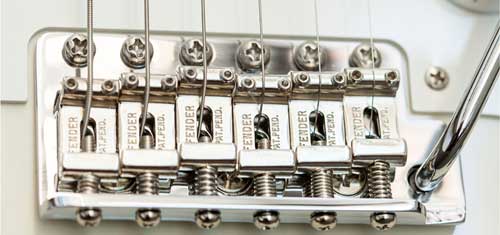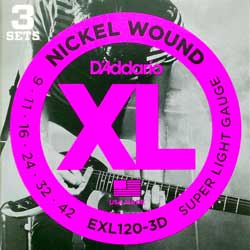This guide covers everything you would want to know about guitar scale length. It explains what scale length, why it’s important, how to measure scale length, and FAQ.
What is Scale Length
A guitar’s scale length is the distance between the nut and the bridge (check out this guide for guitar part names and what they do).

Different types of guitars use different scale lengths. Here is a comparison of different types of guitars and their scale length:
- 24″ (610mm) Fender Jaguar, Fender Mustang
- 24.5″ (622mm) Paul Reed Smith Santana Signature series
- 24.75″ (628mm) most Gibson and Epiphone models
- 25″ (635mm) most PRS, Carvin, and Danelectric models
- 25.5″ (648mm) most Fender, Ibanez, Jackson, Kramer, Schecter, Squier, and Steinberger models
- 26.5″ (673.2mmm) most 7 string models by Ibanez, Jackson & Schecter
- 27-30″ (686 – 762mm) guitars in this range are called ‘baritone’ guitars. Also used by most 8 & 9 string guitars
- 34″ (863.6mm) standard bass guitars
As you can see, there is no ‘normal’ scale length for an electric guitar. The normal scale length for a Fender is 25.5″, but the normal scale length for a Gibson is 24.75″.
How to measure a guitar’s scale length
While you could try to measure a guitar’s scale length by measuring the distance between the nut and the bridge, you’re not going to get an accurate result. If you look at the below photo of a bridge, you can see each string has a different starting point:

Each string has a different length to compensate for intonation. Measuring scale length this way would produce inconsistent results so I don’t recommend trying to measure scale length from the bridge.
A better way to measure scale length is to measure from the nut to the 12th fret, then double the distance:

For example, if you measure the distance from the nut to the 12th fret on a Fender Stratocaster, you should get 12.75″ or 324mm. Double that distance to get the scale length of 25.5″ or 648mm.
How scale length affects playability
Scale length plays a big part in a guitar’s playability. Let’s look at the different ways scale length can change how a guitar feels to play.
String tension
The most important impact scale length makes is on the tension of the strings. The longer the scale length, the higher the tension needs to be to bring the string up to pitch. A short scale length requires very little tension to bring the strings up to pitch when compared to a longer scale guitar.
The tension of the strings plays a big part in playability.
As an example, let’s compare a Fender Stratocaster (25.5″ scale) and a Gibson Les Paul (24.75″ scale). If both guitars used the same gauge strings and were both in standard tuning, you would notice that the Gibson is slightly easier to perform bends and vibrato compared to the Fender. When strumming chords or playing rhythm parts, you would notice that the strings on the Fender feel tighter.
If you were to then compare the Fender and Gibson against a baritone guitar (27″ scale) with the same gauge strings in standard tuning, the difference in tension would be obvious. You would find it much harder to perform bends on the baritone and rhythm playing would feel extremely tight.
Guitar scale length is only one half of the picture when looking at string tension. For the other half, read through my Guide on Guitar Strings. You’ll learn how string gauge can be used to get the right string tension for your needs.
String action
The action of a guitar is the gap between the strings and the frets. A guitar with ‘high action’ has a wider gap than a guitar with ‘low action’.
String action is a result of the tension in strings. Low tension strings need more room to vibrate and without that room you’ll hear fret buzz. If you’ve ever tuned your strings down to a very low tuning (eg: Drop B), you might have noticed two things: the strings became slack, and there was a lot of fret buzz.
Longer scale length guitars increase tension (if the string gauge stays the same), which means you can get lower action without string buzz. A short scale guitar will need higher action when using light strings or else the strings will buzz. You can achieve low action with a short scale guitar, but it requires you to move to heavier gauge strings.
Fret spacing
If you were to play a Fender Jaguar (24″ scale) then play a Fender Stratocaster (25.5″ scale), you might notice that they feel completely different. As scale length increases, the distance between frets also increases.
The below photo gives a rough comparison of different scale guitars so you can see the change in fret distance:

While you might not notice any difference between similar scale guitars, you would definitely notice it on a baritone guitar or a Fender Jaguar.
For most guitarists, the fret spacing isn’t going to make much of an impact on playability. But if you have small or large hands, you might find a different scale length guitar suits you better.
If you’re trying to decide what scale length is right for you, think about your style of playing. Do you like to play a lot of bends and vibrato? Do you like the loose feel of strings or do you prefer a tight set of strings that don’t bend out of tune when you press against them?
The right scale length for you depends on the style of music you play, and what you prefer the feel of.
Scale length and string gauge
You know that scale length affects string tension. A longer scale length guitar will require higher tension to bring the strings up to tune.
Does this mean you’re stuck with high tension strings on long scale guitars? Thankfully, the answer is no.
Scale length is only one half of the picture. The other half is string gauge. String gauge also affects tension and you can change your string gauge to increase or decrease the tension as you need.
For example, let’s say you bought a 26.5″ scale guitar and you don’t like the increase in tension. You’re struggling to play bends as you did on your Gibson. The solution is to move to a lighter string gauge. Each time you move to a lighter string gauge, the tension will decrease. With a light enough gauge, you can end up with exactly the same tension on your 26.5″ scale guitar as you did on your 24.75″ scale guitar.
This is also important to remember if you plan on tuning down. If your guitar is in standard tuning and you tune down to something like Drop C, you will notice the strings become quite slack. If you want to bring the tension back up to what it was like before, you can either buy a guitar with a longer scale length, or you can buy heavier gauge strings.
Find out more about guitar string gauge, tension, and more in this guide: Ultimate Guide to Guitar Strings
The key point to remember is that you need to think about scale length and string gauge together.
Multiscale Guitars
The chances are you’ve seen a guitar like the one below and wondered what it was all about:

The above guitar is a ‘fanned frets’ or multiscale guitar. While they’re rare on 6 string guitars, they’re very common on extended range guitars for a good reason.
As you know, when you increase scale length, string tension increases. If a string is tuned to a low note (eg: the low F# on an 8 string guitar), high tension is needed to stop fret buzz. While you could use a heavy gauge string, you might not like how it feels. You could increase the scale length, but then you need to deal with super high tension on the higher strings.
Multiscale guitars offer a different solution. The lower strings have a long scale length (eg: 28″) and progressively become shorter towards the higher strings (eg: 25.5″). You end up with higher tension on the low strings and lower tension on the higher strings.
Find out everything you would want to know about fanned frets in this guide.
Is a multiscale guitar right for you?
If you play 6 string guitar, the answer is probably no. While these guitars do exist, the benefits are probably not worth it. Try using different gauge strings to achieve the tension you want.
If you play 7 string guitar, the answer is maybe. Most 7 string guitars use a 26.5″ scale. Such a long scale length creates high tension on the higher strings which you may or may not like.
If you play 8 or 9 string guitar, the answer is probably yes. While there are regular 8 and 9 string guitars out there, you will probably prefer the tension and feel of a multiscale guitar. The super-long length on the lower strings means you won’t feel like you’re using bass guitar strings. The shorter scale length on the higher strings will make bends and vibrato easier.
Every guitarist is different so if you’re considering a multiscale guitar, be sure to try one out to see if it feels right to you. Read more about fanned frets in this guide.
Scale Length FAQ
Here are some quick answers to common questions about guitar scale length. If you have a question about scale length not covered above, ask it here.
Q: What is the best scale length for metal?
A: Metal guitarists tend to prefer longer scale lengths (eg: 26.5″ or higher) due to the increased string tension. Having high string tension makes it easier to create a tight and punchy rhythm. If you use a lower tuning (eg: Drop C), a longer scale length means you don’t need to buy super heavy gauge strings.
There is no ‘best’ scale length for any style of music. It all depends on what feels the best to you.
Q: What is a baritone’s scale length?
A: A baritone guitar is a guitar with a long scale length of at least 27″ and can go up to 30″. To give you an idea of how long that is, bass guitars start at around 30″. Baritone guitars are often used for very low tunings.
Q: What is a guitar’s normal scale length?
A: There is no ‘normal’ scale length. Different brands and models use different scale lengths. The most common lengths are 24.75″ for most Gibson models and 25.5″ for most Fender models.
